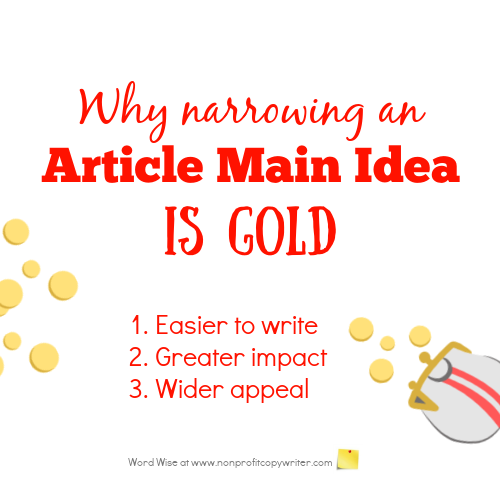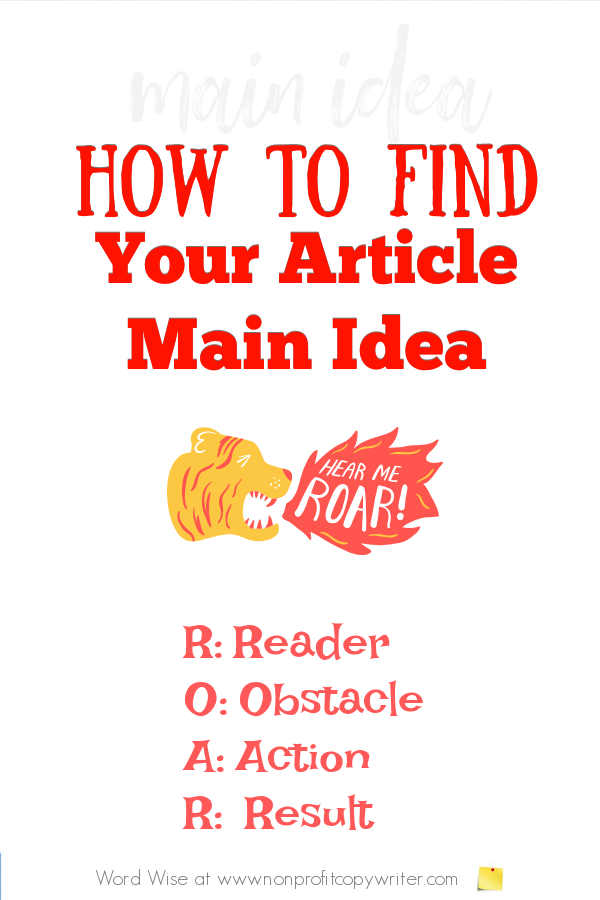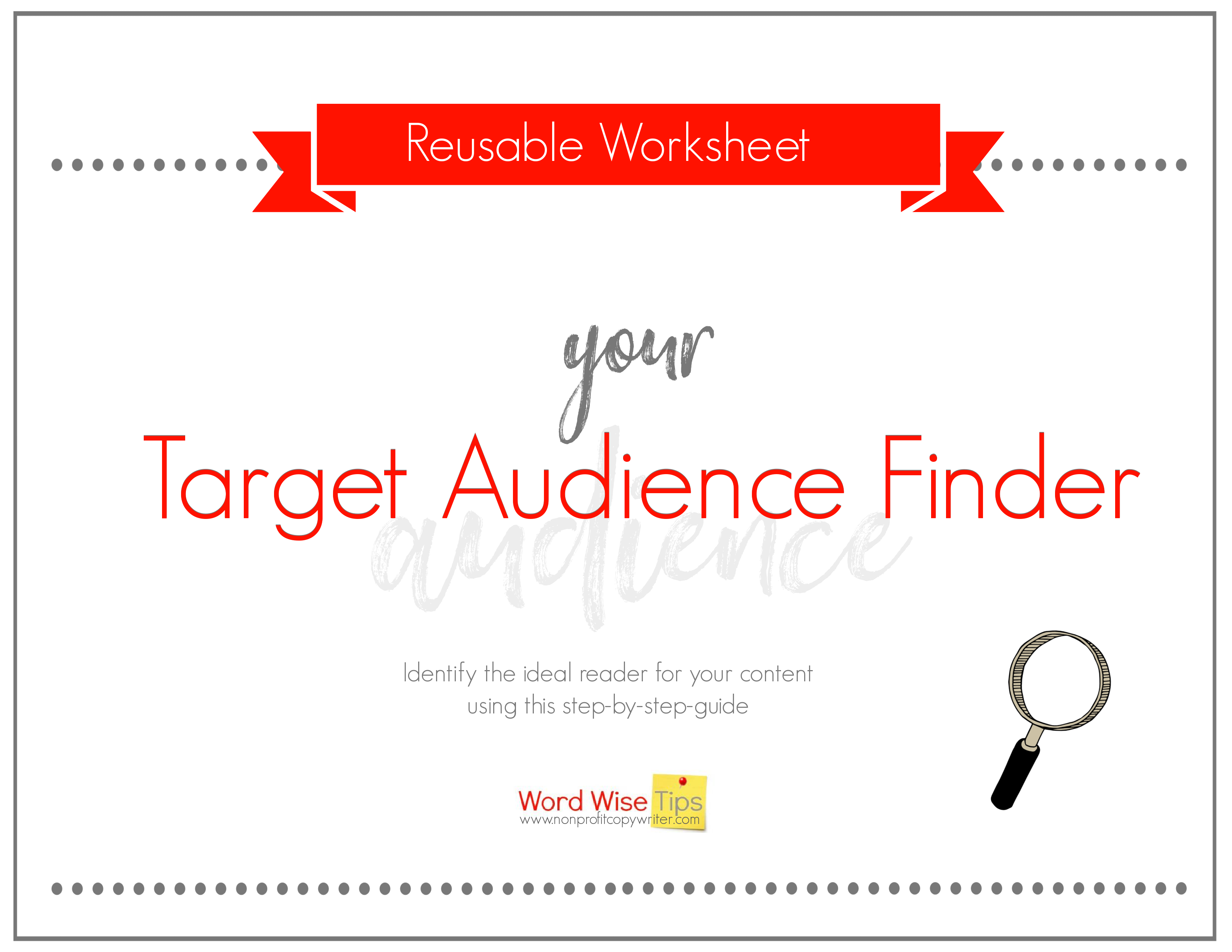Save Time: Get 5 Simple Writing Tips
you can put to use in 10 minutes
How to Narrow Your Article Main Idea
Award-winning writer Kathy Widenhouse has helped hundreds of nonprofits and writers produce successful content , with 750K+ views for her writing tutorials. She is the author of 9 books. See more of Kathy’s content here.
Updated 11.12.25
When I sat down to write this article, all I had was a hazy concept and a couple of keywords I thought I should use. I brainstormed, but I hit a wall. I even tried ChatGPT to drill down my point. In the end, I reverted to my favorite nifty acronym to move from a vague article concept to a solid article main idea.
You, like me, might be so overwhelmed that you simply don’t know where to start writing an article. We are not alone. About half of the 1,200+ members in my private writing Facebook group tell me one of their main writing struggles is, “I don’t know how to get started writing.”
But you don’t have to live with this. You’ve already got an article idea … and ideas are gold. To get started writing, you simply need to drill down that cloudy unformulated impression into a clear main idea and target sentence. From there, words flow much more easily. But first …
Why you should start with an article main idea
An article main idea is the singular point or message your reader takes away. Your article needs one. And you do, too. With an article main idea in hand as you write, all kinds of good things happen, like …
Your article is easier to write.
Follow a simple little process to drill down to your article's main point and you find yourself moving past writer’s block quickly. Words snowball after that.
Even if you get off track (and you will), a clear main idea helps you move off rabbit trails and back to driving your point home. With a focused target sentence in hand, you can make sure that every word you write contributes towards your core message. A clear main idea makes your writing job easier.
You impact your reader.
“We write to create change in the reader.” So says Josh Bernoff, author of Build a Better Business Book.
It doesn’t matter if you write motivational articles, informational articles, feature articles, reviews, how-to articles, profiles, or even shorts. If your article lacks a singular message, it’s much harder for you to have an impact. But when your reader understands your article's main point from the get-go, then there’s a greater chance you’ll inspire them to learn a new skill, adopt a different attitude, acquire understanding, or solve a problem.
Which is why you’re writing the article in the first place, right?
Your article has a wider appeal.
“All pieces of content within a medium compete with one another in what I summed up as a ‘Darwinian battle,’” says author David Kadavy. “Only the strong survive.” Want your article to survive — or dare I say thrive? Without a clear main idea, your article is weaker than others in the same genre — no matter how powerful you believe your message is. Strong writing is clear writing.
You’re a reader. You get this. Don’t you favor consuming content that’s clear and easy to process — especially over other articles that are confusing or esoteric or theoretical?
Mechanics matter. When your article wanders through nebulous concepts, readers are not engaged. They won’t remember what you write, which means they won’t take much away in terms of concrete, helpful, or inspiring content. Which means your article has less appeal and less impact. Only the best articles — those clearest to understand — survive the oversaturated marketplace and find their way onto your tablet or screen.
Find your article main point when you cut away all the dross. You’ll get past the writing hump. You’ll write better. You’ll gain more readers and fans. If a simple tool can help me, I bet it can help you refine your muddy thoughts into a pure, solid gold idea.
How to find your article main idea: use this tool
ROAR: I use this handy acronym as a jumpstart, particularly when I’m stuck getting started writing. Each of its 4 letters represents one question. I answer the 4 questions about my article idea and put it all together in a target sentence.
Then, voila, I’m ready to get started with writing a winning article.
One note: when my article concept is particularly fuzzy, I find I need to spend more time than I want answering the questions. Invest the minutes (or hours, as the case may be.) It’s worth the fight.
R: Reader. Who will read this article and benefit from it?
The answer is not, “everybody.” If you want to write a successful article, you need to drill down your reader to one specific person.
“Don’t try to visualize the great mass audience,” said William Zinsser in the classic On Writing Well. “There is no such audience — every reader is a different person.”
Let’s say you’re going to write an article about how to make a chocolate cake from scratch. It’s a skill plenty of readers want to acquire. But you’ll write the article differently depending upon your intended reader. Are you targeting the seasoned middle-aged cook who wants to finally learn to bake a cake without using a cake mix? Or is your article for a teenager who doesn’t know the difference between a measuring cup and a turkey roasting pan?
Choose one reader for your article. A very specific one. Let’s take the article I’m writing right now. Who is my reader? It’s writers — both new and experienced — who struggle to get started writing.
Find your target reader with this handy, reusable worksheet.
O: Obstacle. What obstacle does your reader face?
An obstacle blocks the way or hinders progress. A user finds and reads your article to get over or around an obstacle — or eliminate the obstacle altogether. The obstacle can be a need for information … confusion about a principle … a question that needs an answer.
Your article identifies the obstacle for the reader. Yes, you need to point out the problem in clear language. When you acknowledge the problem, you eliminate other obstacles — and you drill down to your main point. This is a key step in gaining clarity for your article.
Plus, by identifying the reader’s problem and stating it outright, you earn her trust. She sees you understand the specific obstacle she faces.
To drill down your reader’s obstacle, complete this sentence: “After reading this article, the reader will understand [obstacle]. “
As in, “After reading this article, the reader will understand that baking a chocolate cake from scratch is a skill they can acquire.”
Or perhaps this: “After reading this article, writers will understand one way to get around writer’s block.”
A: Action. What action do you want your reader to take?
Useful articles tell readers exactly what to do. Rather than wandering through a series of rambling thoughts or what-ifs or maybe-thats, your winning article spells out the specific actions your reader can use to overcome his obstacle or problem or issue or thought pattern.
If your article explains how to make a chocolate cake from scratch in 5 steps, then make sure you offer bullets one through five — not four or seventeen. If your article explains a tool to use to circumvent writer’s block to get started writing an article, then offer clear steps the reader should take to use the tool.
R: Result. What’s the result for your reader?
Your reader has accepted that she has a problem or need to address. You’ve given your reader steps to address that problem. Now, if your reader stays with you until the end of the article, what will she accomplish? Your end result may be a piece of information the reader needs… a solved problem… a new skill … a changed attitude … an assurance … a truth that the reader now understands. Unless your article changes the reader, why bother writing it?
Spell out the end result your reader can expect. Record in clear terms how your reader will be different after reading your article.
Use ROAR to write your article main idea
Assemble the answers you’ve created into a single target sentence that looks like this:
After reading this article, [Reader] will understand [Obstacle], so they will [Action] to [Results].
Using this article as our example, we can fill in the blanks.
After reading this article, writers will understand one way to get around writer’s block, so they will use the ROAR acronym to write a clear article main idea.
There. This nifty little acronym got me from the hazy concept of “I should write an article about how I find an article main point” … to “Why don’t I just tell my reader the tool I use?” … to what you are reading now.
Try it. You can jumpstart your article with less sweat and tears, doubt and angst. In the process, you’ll get started writing an article that survives the Darwinian content battle to emerge as a winner.
More Tips about The Writing Process
The 2 Best Ways to Narrow Your Topic for an Article...
How to Write An Article: Get Started With These 12 Steps ...
How to Choose an Article Topic...
How to Test an Article Idea ...
The Foolproof Article Formula I’ve Used to Write 1,000+ Articles ...
How to Brainstorm Blog Post Ideas for Your Blog or Content ...
3 Tips for Starting Your Writing Project ...
Learn To Write Content When You Learn To Write an Article ...
Choose a Story Angle Using These 3 Tips ...
Capturing Ideas for Writing Projects: a System is the Solution ...
Pre-Writing: 4 Easy Steps to Make Your Writing Go Faster ...
Where to Look for Writing Ideas ...
Tips about the Writing Process on our Pinterest board ...
Return from How To Narrow Your Article Main Idea to
Nonprofit Copywriter home
As an Amazon Associate I earn from qualifying purchases.
Share This Page

Named to 2022 Writer's Digest list
BEST GENRE/NICHE WRITING WEBSITE


Stop Wasting Time!
Grab your exclusive FREE guide, "5 Simple Writing Tips You Can Put to Use in 10 Minutes or Less"














